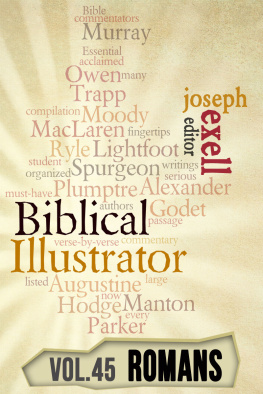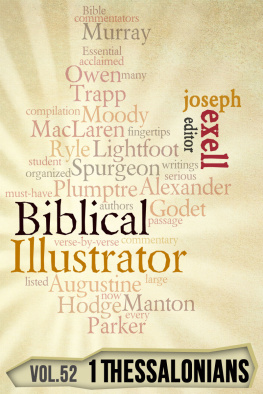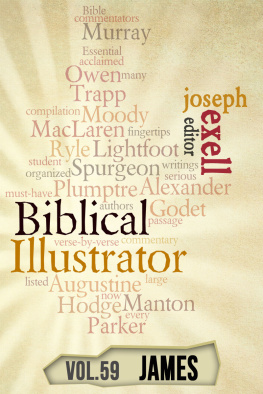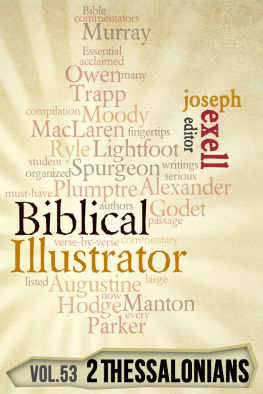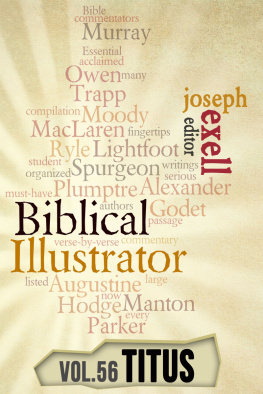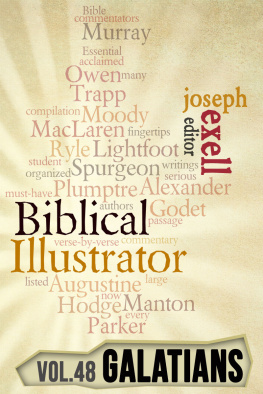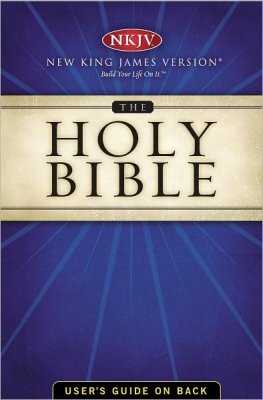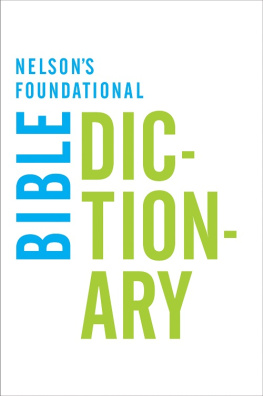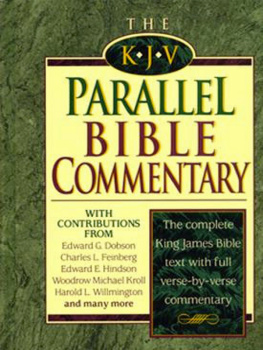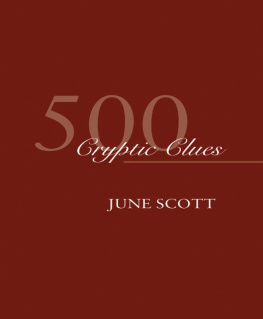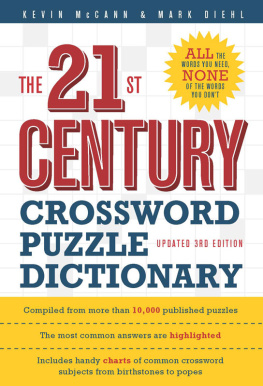Philemon
Series Foreword
What if Charles Spurgeon helped you prepare next Sundays sermon?
Or what if you could talk over your preaching with Joseph Parker, Richard Baxter, Henry Ward Beecher and H. P. Liddon. Do you think it would make a difference to get the input of some of the greatest preachers who ever lived?
Thats precisely what Joseph Exell had in mind when he put together the massive series of volumes called The Biblical Illustrator. In what can only be called a Herculean feat, he spent years gathering preaching notes and sermon outlines from the very best preachers of his day (in the late 1800s and early 1900s), and he did it covering every book of the Bible.
Following the tradition of the time, he gave the series a flowery subtitle, describing it as anecdotes, similes, emblems, illustrations, expository, scientific, geographic, historical and homiletic, gathered from a wide range of home and foreign literature, on the verses of the Bible. He means that in these volumes you have everything you need in order to preach a sermon, teach a Bible class, or study a text on your own.
And it is amazingly comprehensive. Exell approached his task by taking every verse in the Bible and seeking to discover how it has been preached in the past. Though there is plenty of exegetical material here, this is not primarily a commentary.
This series is for preachers, teachers and Bible students.
Besides obviously being an omnivorous reader, he had a gift for amazing diligence. The Biblical Illustrator was published in 66 volumes. To give you a sense of how comprehensive it is, volume 49 contains 588 pages on Galatians. And the type in the original version was very small, with narrow margins so you almost had to have a magnifying glass to read it. But Joseph Exell had something in mind other than publishing a stylish book. He wanted to give preachers a book so complete that you could give it to someone and say, Go preach Galatians, and they could do it.
No one could ever use all the sermon outlines in the Biblical Illustrator. But thats not the point. We all agree that the best preacher starts with your study of the biblical text. But at some point you need to know what others have seen in the same text you are studying.
What did Spurgeon see?
What did Parker see?
What did Alexander MacLaren see?
Maybe you will see the same thing they did. Probably you will see something similar. But its entirely possible that Spurgeon (who has a flair for memorable phrasing) captured the thought of the text in a way that never occurred to you.
And there are times when the preacher needs some help in priming the pump. We all know what its like to be stuck in some passage of the Bible. You know what it says, you have studied the words, you have read a few commentaries, but somehow the message isnt jelling in your mind. Thats where the Biblical Illustrator is likely to be most helpful to you. If you are preaching on, say, Hebrews 10:19-25, you can find real help in the Biblical Illustrator. There is an expanded sermon outline by J. Colwell that almost anyone could expand into a profitable message. There is a lengthy and intricate outline by the Puritan pastor Thomas Boston and a moving exposition of Christ our high priest by Adolph Saphir.
Thats just one tiny example of one text. And Joseph Exell does that for every text in the Bible.
Its a phenomenal piece of work, and one that stands up very well more than a century later. I know of no comparable collection that has been done since then. I doubt if anyone would have the time or energy to attempt such a massive project today.
I bought my first copy of the Biblical Illustrator almost 20 years. Back then it came in six or seven massive volumes, printed on oversized pages with type so tiny I could hardly read it. About 10 years ago I purchased a CD with the Biblical Illustrator in PDF format. That was a huge improvement. But with the advent of ebook technology, we at last have the Biblical Illustrator in its most useful format. Because it is indexed to each section of the book, you can quickly find the passage you are looking for. And you can enlarge the text as much as you like.
As you can tell, Im big fan of the Biblical Illustrator because it preserves the wisdom of an earlier age. I would fully agree that you must start with your own study of the text, and we definitely need the fruit of recent biblical commentaries. But alongside your own study and the reading of current commentaries, there is a large place for reading the Biblical Illustrator.
Joseph Exell wanted to help preachers, teachers, and everyday Bible students. He succeeded admirably in his task. The fruit of his labors is now available for the first time in ebook format, making it more usable today than when it was first published.
For those who want to study the Bible and then teach it to others, the Biblical Illustrator will help you on every single text in the Bible. For over a century preachers and teachers have turned to it and found what they needed. I gladly say that it has often helped me, and I am glad to commend this series to you.
Dr. Ray Pritchard
President, Keep Believing Ministries
April 2012
Dallas, TX
Introduction
Authorship
The testimonies to the Pauline authorship of this Epistle are abundant.
1. E xternal. It is not quoted so often by the earlier Christian fathers as some of the other letters; its brevity and the fact that its contents are not didactic or polemic, account for that omission. We need not urge the expressions in Ignatius, cited as evidence of that apostolic father's knowledge and use of the Epistle, though it is difficult to regard the similarity between them and the language in ver. 20 as altogether accidental. The Canon of Muratori, which comes to us from the second century, enumerates this as one of Paul's Epistles. Tertullian mentions it, and says that Marcion admitted it into his collection. Sinope, in pontus, the birthplace of Marcion, was not far from colosse where philemon lived, and the letter would find its way to the neighbouring churches at an early period. Origen and Eusebius include it among the universally acknowledged writings of the early Christian times. It is so well attested historically, that De Wette says its genuineness on that ground is beyond doubt.
2. I nternal. It is impossible to conceive of a composition more strongly marked within the same limits by those unstudied assonances of thought, sentiment, and expression, which indicate an author's hand, than this short Epistle as compared with Paul's other productions. It will be found also that all the historical allusions which the apostle makes to events in his own life, or to other persons with whom he was connected, harmonise perfectly with the statements or incidental intimations contained in the Acts of the Apostles or in the other Epistles of Paul. (H. B. Hackett, D. D.)
The authenticity of this Epistle was probably never very seriously denied; its inspiration was unpopular in certain quarters, external to the Church. It is very necessary to remember that the objections to the inspiration of the letter came from anti-dogmatic, not from dogmatic Christians; that "in the battle of the creeds" the defenders of the Catholic doctrine are the champions of the Epistle; that "the fierce current of prejudice," stemmed by Jerome, Chrysostom, and Theodore of Mopsuestia, set in from a quarter external to the Church. Jerome states that the arguments used against the Epistle were, either that it was not St. Paul's, or that, if it came from his hand, he was not always inspired. Its subject, they argued, proved that it was a commendatory note, not a dogmatic document. Jerome argues that its universal reception by all churches in the whole world is unaccountable, except on the hypothesis of a Pauline origin. As to apparent triviality and everyday style, he points to such passages as 2 Timothy 4:13, Galatians 5:12, 1 Corinthians 7:12, with their apparently petty details, outbursts of human feeling, admissions of uncertainty. For the brevity of the letter he refers to the Minor Prophets, and concludes by a quaint quotation of Romans 9:28, as if the very shortness of Philemon were in consonance with the spirit of the gospel. (Bp. Win. Alexander.)


